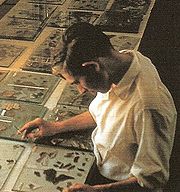
Aramaic Enoch Scroll
Encyclopedia
The Aramaic Enoch Scroll is a non-published, privately owned, complete copy of the Book of Enoch
.
There is no absolute public proof of its existence, but according to the former chief editor of the official Dead Sea Scrolls
editorial team, John Strugnell
(deceased 2007), the scroll is well preserved, and microfilmed. Strugnell was shown the microfilm in 1990, during the Kuwait crisis, but was never able to buy it for the editorial team.
Another person who has stated having seen the scroll or the microfilm, is Gerald Lankester Harding
, who was the director of Jordan's Department of Antiquities (1936–1956).
 The scroll is said to have been found in the Qumran
The scroll is said to have been found in the Qumran
"Cave 11", in 1956, together with the other, already publicized scrolls and fragments. This cave was found by the same Bedouin, Abu Dahoud
, who found the first cave in 1947.
Apart from this and another scroll from Cave 11 that Strugnell had seen personally, he had heard Harding speak of at least 2 never published scrolls from the same find. These, or some of them, were at that time (the Kuwait crisis) about to be bought by private, probably European collectors or bankers. The reason for buying them was for investments. Although Strugnell had arranged with serious buyers who would publicize the scrolls, he was not able to convince the owners to sell.
Abu Dahoud has confirmed that he and 10 other men found the cave, and sold the scrolls to many different people.
The Parables is a part of the Ethiopian translation of the Book of Enoch. It is disputed how old it is and if it was originally a part of Enoch (although today most scholars believe it to be pre-Christian). If it was proven to have been a part of the original Aramaic book, it would mean that all of its prophecies concerning the coming Son of Man
, which some argue refers to Jesus, would have been written before Jesus was born.
Book of Enoch
The Book of Enoch is an ancient Jewish religious work, traditionally ascribed to Enoch, the great-grandfather of Noah. It is not part of the biblical canon as used by Jews, apart from Beta Israel...
.
There is no absolute public proof of its existence, but according to the former chief editor of the official Dead Sea Scrolls
Dead Sea scrolls
The Dead Sea Scrolls are a collection of 972 texts from the Hebrew Bible and extra-biblical documents found between 1947 and 1956 on the northwest shore of the Dead Sea, from which they derive their name...
editorial team, John Strugnell
John Strugnell
John Strugnell, was born in Barnet, Hertfordshire, UK. At the age of 23 he became the youngest member of the team of scholars led by Roland de Vaux, formed in 1954 to edit the Dead Sea Scrolls in Jerusalem...
(deceased 2007), the scroll is well preserved, and microfilmed. Strugnell was shown the microfilm in 1990, during the Kuwait crisis, but was never able to buy it for the editorial team.
Another person who has stated having seen the scroll or the microfilm, is Gerald Lankester Harding
Gerald Lankester Harding
Gerald Lankester Harding was the Director of the Jordanian Department of Antiquities for twenty years. His tenure spanned the period in which the Dead Sea Scrolls were discovered and brought to public awareness...
, who was the director of Jordan's Department of Antiquities (1936–1956).
Qumran Cave 11

Qumran
Qumran is an archaeological site in the West Bank. It is located on a dry plateau about a mile inland from the northwestern shore of the Dead Sea, near the Israeli settlement and kibbutz of Kalia...
"Cave 11", in 1956, together with the other, already publicized scrolls and fragments. This cave was found by the same Bedouin, Abu Dahoud
Muhammed edh-Dhib
Muhammad Ahmed al-Hamed , better known by his nickname Muhammed edh-Dhib , was a Bedouin shepherd from the Ta'amireh clans residing in Bethlehem, who discovered the Dead Sea Scrolls in winter 1946/47....
, who found the first cave in 1947.
Apart from this and another scroll from Cave 11 that Strugnell had seen personally, he had heard Harding speak of at least 2 never published scrolls from the same find. These, or some of them, were at that time (the Kuwait crisis) about to be bought by private, probably European collectors or bankers. The reason for buying them was for investments. Although Strugnell had arranged with serious buyers who would publicize the scrolls, he was not able to convince the owners to sell.
Abu Dahoud has confirmed that he and 10 other men found the cave, and sold the scrolls to many different people.
Importance
The importance of a complete Aramaic manuscript of the Book of Enoch could be immense. Michael Wise, a DSS scholar, writes: "No trace of the Parables of Enoch has been discovered at Qumran, and it is widely considered today to be a composition of the later first century C.E. If a pre-Christian copy of the Parables were ever discovered, it would create a sensation"The Parables is a part of the Ethiopian translation of the Book of Enoch. It is disputed how old it is and if it was originally a part of Enoch (although today most scholars believe it to be pre-Christian). If it was proven to have been a part of the original Aramaic book, it would mean that all of its prophecies concerning the coming Son of Man
Son of man
The phrase son of man is a primarily Semitic idiom that originated in Ancient Mesopotamia, used to denote humanity or self. The phrase is also used in Judaism and Christianity. The phrase used in the Greek, translated as Son of man is ὁ υἱὸς τοὺ ἀνθρώπου...
, which some argue refers to Jesus, would have been written before Jesus was born.

